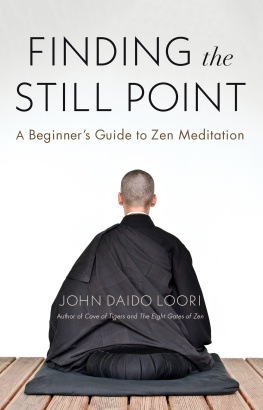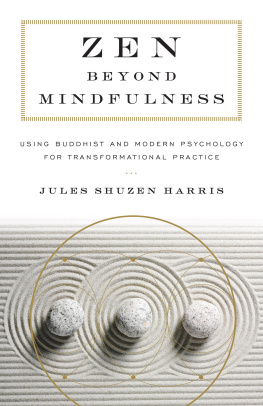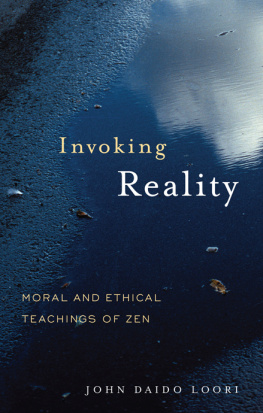This book is living testimony that the flower of the Buddhas enlightenment has crossed the Pacific Ocean unsullied and taken root in American soil.
Tricycle
Sufficiently deep, yet clear and easy to read, this has the potential to become a fundamental handbook broadening practice in this country.
Publishers Weekly
ABOUT THE BOOK
This accessible introduction to the philosophy and practice of Zen Buddhism includes a program of study that encompasses practically every aspect of life. The American Zen teacher John Daido Loori shows us that Zen practice should include not only meditation, the study of Zen literature and liturgy, and moral and ethical action, but should also manifest in work, artistic, and everyday activities. The Eight Gates are:
- Zazen, a type of meditation described as sitting Zen
- Face-to-face meetings between teacher and student
- Academic study of the sutras related to Zen training, other schools of Buddhism, Buddhist history, psychology, and philosophy
- Zen rites and rituals and their meaning
- The moral and ethical requirements set in the Buddhist Precepts
- Art practice as an extension of Zen practice
- Body practice as an extension of Zen practice
- Work as an active function of zazen
Beautifully illustrated with Looris own photographs, this edition also includes a new introduction and an updated reading list.
JOHN DAIDO LOORI (19312009) was one of the Wests leading Zen masters. He was the founder and spiritual leader of the Mountains and Rivers Order and abbot of Zen Mountain Monastery. His work has been most noted for its unique adaptation of traditional Asian Buddhism into an American context, particularly with regard to the arts, the environment, social action, and the use of modern media as a vehicle of spiritual training and social change. Loori was an award-winning photographer and videographer. His art and wildlife photography formed the core of a unique teaching program that integrated art and wilderness training by cultivating a deep appreciation of the relationship of Zen to our natural environment. He was a dharma heir of the influential Japanese Zen master Taizan Maezumi Roshi and he authored many books.
Sign up to learn more about our books and receive special offers from Shambhala Publications.

Or visit us online to sign up at shambhala.com/eshambhala.
THE EIGHT GATES OF ZEN
AProgram of Zen Training
JOHN DAIDO LOORI
EDITED BY
BONNIE MYOTAI TREACE
AND
KONRAD RYUSHIN MARCHAJ

SHAMBHALA
Boston & London
2013
Shambhala Publications, Inc.
Horticultural Hall
300 Massachusetts Avenue
Boston, Massachusetts 02115
www.shambhala.com
1992, 2002 by the Mountains and Rivers Order
Cover photograph: Archives of Zen Mountain Monastery
Previously published under the title The Eight Gatesof Zen: Spiritual Training in an American Zen Monastery.
Published by arrangement with Dharma Communications, Mt. Tremper, New York.
All rights reserved. No part of this book may be reproduced in any form or by any means, electronic or mechanical, including photocopying, recording, or by any information storage and retrieval system, without permission in writing from the publisher.
Library of Congress Cataloging-in-Publication Data
Loori, John Daido.
The eight gates of Zen: a program of Zen training/John Daido Loori.1st Shambhala ed.
p. cm.
Originally published: Mt. Tremper, N.Y.: Dharma Communications, 1992.
eISBN 978-0-8348-2390-7
ISBN 978-1-57062-952-5
I. Title
BQ9288 .L662 2002
294.344dc21
2002075778
Dedicated with deep gratitude to all of the teachers who have transmitted this incredible Buddhadharma from East to West
Nine Bows
I come here realizing the question of Life and Death is a vital matter
I wish to enter the Zen training program of Zen Mountain Monastery
I understand the rules of this temple and assume full responsibility for maintaining them
Please, guide me in my practice.
Since the Fall of 1980 over six hundred people have stood at the threshold of the zendo at Zen Mountain Monastery and read this petition aloud. The common understanding and intent expressed at this juncture of entry into formal training is, in one sense, the subject of The Eight Gates of Zen. Beneath that lies a shared koan: what exactly is being entered, who enters, how does one assume full responsibility, how can we guide one another?
Living at the Monastery today are five of us who have taken lifetime vows as monks, along with thirty resident trainees. We are given a chance to take care of the teacher, the century-old stone building, and several hundred acres of grounds. Residents also are charged with maintaining the continuity of the daily schedule, following the rules set out in the Doshinji Code, and running the business end of the institution: the student training program, a vigorous calendar of training retreats for hundreds of visitors each year, a communications company, prison outreach, community service. Residents help provide a place to train intensively and an atmosphere that is both taut with commitment, and tender with the constant, subtle reminder that the self doesnt end with the skin-bag.
Students living away from the Monastery, like spokes emanating from the hub of a wheel, provide the connection between the mountain and the worldreaching out with their practice into social and political relationships, and reaching back into the monastic heart, to sustain the teacher and the monks. In settings and situations that often offer little or no support for spiritual life, the vow to be a student, to live with a students gutsy faith, doubt and determination, takes many forms.
The koan of entry is particularized by each person who engages it. That is the critical spin on the wheel, the motion of the heart to wonder, to investigate, to offer ourselves full-out to whatever is most true. What is it that spins the wheel, that opens and enters as gates all that once stood as life barriers, closed places, places where our hearts would die innumerable small and large deaths? In entering this training, we are given eight directions, like illuminated pathways leading both out and in, each with a gate to be opened, each leading squarely back to the home we never leave but almost never appreciate.
Having been part of the training at the Monastery for the last ten years has been a wonderful adventure, if difficult to comment on. In the midst of it, the view is a little like the haiku by Basho:
My horse tramping
across the field, Ha!
Im in the picture!
One thing that shouldnt be overlooked in this basically impossible project of defining, picturing, this spinning wheel of The Eight Gates, is the fact that though centered, it is undeniably in motionan evolving process ceaselessly refining itself. One of the Monasterys most invigorating implications is the kind of energy it insists on. Nothing waits. Though the current picture may not capture all the nuances and permutations, all the history and influences, we commit to it with total conviction. Throughout the time Ive been both in and observing the matrix of training here, the mysterious grace that forms around doing ones best has been the saving grace itself: technically, the Monastery should not have survived its improbable beginnings, the strains of money and personalities, the raging storm waters spilling into the dining hall during the flash flood, the bitter Catskill winters. It has been, above all, a seamless lesson in what happens when a person, human and full of all the requisite foibles, persists in practicing selflessness. Others come. Fires start in the heart. Impossible things happen, and begin to take on the clothes of ordinary beings doing ordinary things. For no rational reason, people give, take care of each other first, ask for nothing, endure hardship, offer incense to those long dead and those not yet born.
Next page








